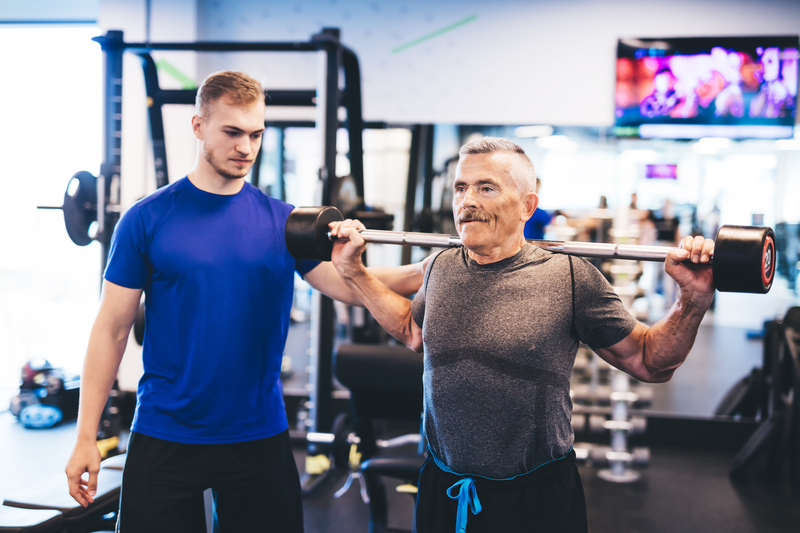How to Maintain Muscle and Strength After 50

Whether you’re a lifelong athlete or you’re new to the fitness game, once you cross into (or well past) your fifth decade of life, you’ll likely notice your body has gone through some surprising changes. Perhaps your recovery has slowed or it’s harder to push your body as much as you once did or you just don’t feel as coordinated. That doesn’t mean it’s time to “slow down.” In fact, at 50 and above, it’s more important now than ever before to maintain muscle and promote strength!
Physical Changes After 50
Normal aging is often associated with declines in strength, stamina, speed, coordination, and balance. For example, after the age of 40, muscle size can decline by 1% to 2% yearly, and strength can decrease by 1.5% to 5% every year (averaging around 3% per year once you hit middle age). This can make it more difficult to lift even familiar objects like a bag of groceries, suitcase, or laundry basket.
Together, this can make it harder to prevent (or recover) from falls, make it more difficult to speed up to catch transportation, safely walk around on uneven or slippery surfaces, and even get the groceries from the store into the house, much less keep up with the kids and grandkids. Worst of all, it can decrease your quality of life and even lower life expectancy.
Why do we find it so hard to maintain muscle? First off, when muscle fibers diminish too much, they simply die. And fast-twitch fibers tend to shrink faster than other fibers, which leads to less power and speed.
In addition, muscle repair also decreases as we age due to declining hormones, such as testosterone, estrogen, growth hormone, insulin-like growth factor, and DHEA (dehydroepiandrosterone).
Coordination can decline not only due to decreased muscle mass and strength but because of changes in the brain and nervous system. This can negatively influence our ability to keep a plate of food steady as we move from one end of the room to the next or impact our sporting abilities, including golf, tennis, or pickleball.
But just because the changes are normal doesn’t mean they’re inevitable. In fact, much of the reason for these declines is directly tied to the consumption of a Western (or Standard American) diet combined with a sedentary lifestyle. This combination of factors over time (especially after the age of 60) can increase the risk of micro-strokes (aka microvascular or small vessel disease) in the white matter in the brain. These “strokes” are so minimal that they’re undetected as they occur, but they can lead to decreased connections in the brain’s coordination centers.
As we age, we also see a decline in dopamine-producing cells, which can affect movement patterns and decrease coordination. Finally, changes in vision (e.g., cataracts, glaucoma, macular degeneration, and others) can decrease hand-eye coordination and may indicate the beginning of cognitive disorders associated with advancing age.
Again, though, just because these types of changes are common doesn’t mean we’re powerless. There’s a lot we can do to maintain muscle and strength well into our 50s, 70s, and beyond. And older lifters have paved the way to show us how to not only maintain muscle but build it. It starts by working smart.
How to Maintain Muscle and Promote Strength After 50
The top reason people find it difficult to maintain muscle and strength as they age is simply because they slow down and decrease activity levels. It’s common for people to simply do less as they get older. Unfortunately, that slowdown leads to even greater declines.
To maintain muscle, as we get older, we need to reverse our thinking and ensure we stay active and invest in regular exercise. Simply increasing the amount of time we move our bodies is one of the best ways to counteract the changes in hormones and other bodily functions. Indeed, exercise has been found to be the ultimate fountain of youth!
That said, more isn’t necessarily better. As we age, we may need to adjust activities to ensure we promote recovery and prevent injuries. Here’s how to maintain muscle, no matter how young or old you are:
• Stay active: Disuse of muscles is one of the primary causes of muscle and strength loss. Simply decreasing the amount of walking and other common activities can result in a decline in muscle size and strength. Remember the adage: use it or lose it.
• Prevent injury: Immobilization due to an injury or illness can result in a rapid loss of muscle mass. As strength declines, so do energy levels, which can make it more difficult to return to normal activities once you recover. It’s worth the effort, though, to rebuild what you may have lost.
• Eat protein: As many people age, they tend to eat less in general and eat a lower protein diet in particular, often due to changes in tastes or difficulties with chewing because of teeth or gum issues or difficulties with swallowing or digestion. It can also be harder to shop and cook. To maintain muscle, consume 25 to 30 grams of protein at every meal. Protein supplements can make it easier to consume enough.
• Prioritize sleep: Sleep is vital for muscle recovery and has even been shown to help improve skills as you dream. Practicing quality sleep hygiene is another simple way to reduce the effects of aging.
• Manage inflammation: While normal inflammation is vital to a healthy body, chronic or long-term inflammation can disrupt the body’s ability to recover and heal, which can decrease muscle mass.
• Control stress levels: Extended stress can also decrease muscle recovery and lead to losses in strength and mass.
• Know your limits: You can still recover from intense workouts, but you may need more time. You may also find your work capacity and ability to recuperate start to decrease as you age. Limit the amount of time it takes you to complete your workouts (e.g., no more than 45 to 50 minutes per session) or stop after a set number of total sets (e.g., 8 to 10 per muscle).
Exercise: The Foundation of Youth
The best way to maintain muscle and strength is to challenge your muscles. That includes a combination of aerobic exercises with regular resistance training and mobility and balance movements.
Priority #1: Resistance Training
The most direct way to maintain and even gain muscle is to weight train, use bodyweight movements pushing against gravity, or use resistance bands. The goal is to challenge the muscle fibers, so they’ll signal cells to grow and boost strength. This also helps increase the release of growth-promoting hormones, which help muscle cells grow, repair, and synthesize new proteins.
Studies have found that even older adults (up to 94 years old) who worked out three times a week with exercises like leg presses and leg extensions were able to increase muscle strength over a 12-week program.
Shoot for 2 (full body) to 4 (upper and lower body splits) sessions of no more than 45 minutes to allow your body to fully recover between workouts. If you haven’t been training, remember to start with less and ease your way into longer, more intense workouts. For instance, start with just one set per muscle group and add more sets every few weeks until you can perform three or four sets per exercise.
One set is better than none, but building up to two or more sets is even better. Research, for instance, suggests that doing two sets per workout led to 40% greater gains than doing just a single set.
Many experts recommend starting with compound movements (which use more than one joint at a time) like squats, push-ups, dumbbell bench presses, deadlifts, rows, lat pulldowns, overhead presses, and then add isolation exercises like biceps or hamstring curls or triceps or leg extensions to focus on specific body parts.
While large compound movements are the mainstays of your workout, you can recover more quickly from isolation exercises. This means you can work out more often with less risk of injury. For instance, focus one session per week on more compound movements and the second session with more isolation exercises. Or, start the workout with compound movements and finish off with isolation exercises.
To help prevent injury, you may also want to replace standard barbell lifts with dumbbell lifts, which don’t restrict range of motion and allow your body to move more comfortably even if you’ve lost some elasticity or flexibility. And don’t be afraid to modify exercises to make them safer. For instance, if you have had shoulder injuries, you can move your dumbbell bench press to the floor rather than a bench to better protect your shoulders while building your chest. You can also switch out standard deadlifts with Romanian deadlifts to better build strength in your lower back and hamstrings.
Priority #2: Aerobic Exercise and Endurance
Increasing your heart rate during regular aerobic or endurance training can also help maintain muscle mass when combined with regular resistance training. Choose from a wide range of activities like cycling, jogging, hiking, brisk walking, swimming, dancing, and more. Start with 15 minutes and work your way up to 30 minutes to an hour over 12 months.
RELATED: Collagen Doesn’t Work (Unless…)
While you can burn more calories with more intense aerobic exercise, one of the most underrated ways to move the body is simply walking. This free, easily accessible exercise has been shown to prevent and even reverse muscle loss, especially for people who have already started to lose muscle. Start where you are and increase your total distance by around 10% monthly and slowly build up your pace as your fitness levels increase.
Priority #3: Balance and Flexibility
Yes, the goal is to maintain muscle, but you also want to be able to move easily through your day. That’s why including balance, flexibility, and mobility movements in your routine is vital. Mobility can also improve your fitness and strength. Best of all, having greater mobility helps you feel good and helps decrease the risk of injury.
Priority #4: Work Hard, But Recover Harder
Muscle gains happen when you leave the gym and allow your muscles to fully recover. As you get older, you may need more time to recover from intense workouts. In addition to ensuring you’re getting enough sleep, you’ll also want to give your body a little more TLC in the form of foam rolling, stretching, gentle yoga, and other types of recovery.
Balance Your Nutrition
Ensuring you’re eating enough quality calories can also help you maintain or even gain muscle and strength. In addition, some nutrients can help boost muscle mass and promote exercise recovery and improvements. Top nutrients include:
• Protein is necessary for muscle recovery and to build new muscle tissue. Yet as we get older, our muscles are less responsive to the protein we consume. So, it’s even more important to prioritize getting protein at every meal. Studies indicate men over 70 years old who consumed 35 grams of protein per meal experienced an increase in muscle mass, whereas men in their 20s may only need 20 grams. Leucine, an amino acid found in whey protein, meat, fish, and eggs, is particularly helpful when it comes to promoting muscle gains.
• HMB is a metabolite of the amino acid leucine that’s been shown to help aid exercise recovery. It’s typically found in powders, tablets, and capsules as a supplement and may help promote muscle synthesis, boost exercise performance, and help with muscle recovery.
• Creatine is a nutrient found in meats and made within the body. To get enough creatine to promote muscle, supplementation is typically recommended. One of the most highly studied supplements, creatine has been found to promote the benefits of resistance training to build or maintain muscle size and strength.
• Vitamin D is another nutrient that’s been shown to increase muscle mass and strength. It’s also been found in research to help reduce the risk of falls.
• Omega-3 Fatty Acids are another nutrient needed to maintain muscle at every age. For example, one study found that women who used omega-3 supplements combined with a regular resistance training routine increased strength more than women who didn’t. Researchers believe this may be due to both managing levels of healthy inflammation and directly signaling muscles to grow.
How to Maintain Muscle and Strength After 50: A Wrap-Up
Losing muscle size and strength after middle age is not only common, it’s expected. But that doesn’t mean it’s inevitable. Simple lifestyle changes can help you maintain muscle mass and strength—or even gain muscle to turn back the clock and increase quality of life and potentially extend lifespan.
Most importantly, it’s never too late to maintain or even build muscle size and strength. In less time than you may believe (12 to 16 weeks), you can start rebuilding your muscle and potentially boost fat loss at the same time.








